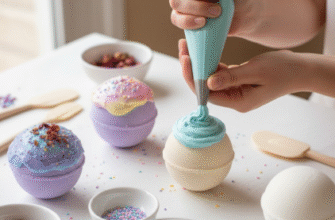Dropping a colourful, fizzing bath bomb into a tub of warm water feels like the ultimate act of self-care for many. It transforms an ordinary bath into a spa-like experience, often complete with enticing scents, vibrant colours, and skin-softening ingredients. But have you ever paused to think about what exactly makes those balls fizz and foam, or what gives them their scent and colour? Not all bath bombs are created equal, and knowing what ingredients to look for – and which ones you might want to sidestep – can make your relaxing soak even better for your skin and peace of mind.
The Heart of the Fizz: Core Ingredients
At their most basic, bath bombs rely on a simple chemical reaction to create that delightful effervescence. Understanding these core components is the first step.
Sodium Bicarbonate (Baking Soda)
This is usually the primary ingredient. Sodium bicarbonate is alkaline, and when it comes into contact with an acid in water, it releases carbon dioxide gas – those are the bubbles! It’s also known for its water-softening and gentle cleansing properties. It’s generally very well-tolerated by most skin types.
Citric Acid
This is the necessary acid component that reacts with the baking soda. Derived often from citrus fruits, it’s what provides the ‘fizz’ power. Together, baking soda and citric acid are the dynamic duo that makes a bath bomb a bath bomb. They are generally considered safe and are food-grade ingredients.
Skin-Loving Additions: What to Look For
Beyond the basic fizz, quality bath bombs often include ingredients designed to moisturize, soothe, and pamper your skin. These are the extras that elevate the experience.
Natural Oils and Butters
These are your moisturizing powerhouses. Look for ingredients like:
- Shea Butter: Rich in vitamins and fatty acids, deeply moisturizing and soothing.
- Cocoa Butter: Creates a protective barrier on the skin, locking in moisture. It often has a faint, pleasant chocolatey scent.
- Coconut Oil: A popular choice known for its moisturizing and potential antimicrobial properties.
- Olive Oil: Rich in antioxidants and very hydrating.
- Jojoba Oil: Closely mimics the skin’s natural sebum, making it easily absorbed and balancing.
- Sweet Almond Oil: A lighter oil, good for sensitive skin and rich in Vitamin E.
These natural emollients help counteract any potential drying effect from the salts or the water itself, leaving your skin feeling soft and supple after your bath.
Beneficial Salts
Salts are often added for more than just texture; they can contribute to the relaxation factor.
- Epsom Salts (Magnesium Sulfate): Not actually a salt in the traditional sense, Epsom salt is a mineral compound of magnesium, sulfur, and oxygen. People have long soaked in Epsom salt baths to ease tired muscles and promote relaxation. While large-scale scientific backing for transdermal magnesium absorption is debated, many users swear by its soothing effects.
- Sea Salt / Himalayan Pink Salt: These contain various trace minerals. They can have gentle exfoliating properties and contribute to a spa-like feel.
Clays
Natural clays can add silkiness to the bath water and offer gentle skin benefits.
- Kaolin Clay: A very mild clay, suitable for sensitive skin. It helps to gently cleanse and soften the skin, and it can also help harden the bath bomb.
- Bentonite Clay: Known for its absorbent properties, it can help clarify the skin.
- Rose Clay: A type of kaolin clay that provides a natural pink colour and is excellent for gentle exfoliation.
Natural Colourants
Instead of synthetic dyes, some bath bombs use natural ingredients for colour. These are often gentler on the skin and less likely to stain your tub.
- Clays: As mentioned, clays like rose clay (pink), French green clay (green), or purple Brazilian clay offer colour.
- Spices & Powders: Turmeric (yellow/orange), spirulina (green), activated charcoal (grey/black), cocoa powder (brown), beetroot powder (pink/red) can be used.
- Plant Extracts: Annatto seed (orange), alkanet root (purple/grey).
The colours might be more muted than synthetic options, but they come with the peace of mind of being naturally derived.
Essential Oils
For scent, pure essential oils are a fantastic alternative to synthetic fragrances. They offer genuine aromatherapy benefits.
- Lavender: Famous for its calming and relaxing properties, perfect for a pre-bedtime bath.
- Chamomile: Gentle and soothing, often used for relaxation.
- Eucalyptus / Peppermint: Invigorating and clarifying, great for feeling refreshed (use with caution, can be intense).
- Citrus Oils (Orange, Lemon, Bergamot): Uplifting and mood-boosting. Note that some citrus oils can be phototoxic, but this is less of a concern when diluted in bath water and rinsed off.
- Ylang Ylang: Exotic, floral, and often associated with stress relief.
Always look for pure essential oils on the ingredient list, not just “fragrance oil” if you want the therapeutic benefits.
Proceed with Caution: Ingredients You Might Want to Avoid
While many bath bomb ingredients are harmless, some common additives can be problematic for sensitive skin, contribute to environmental issues, or are simply unnecessary fillers.
Pay close attention to fragrances and dyes! Synthetic fragrances (often listed as ‘Parfum’ or ‘Fragrance’) are common culprits for skin irritation and allergic reactions. Likewise, artificial colourants (like FD&C Blue No. 1) can cause sensitivity for some individuals and may stain porous tub surfaces.
Artificial Fragrance / Parfum
This single word on an ingredient list can hide dozens, sometimes hundreds, of undisclosed chemicals. Manufacturers aren’t required to list the individual components of their fragrance mixtures. This lack of transparency means you don’t know exactly what you’re soaking in, and some of these hidden chemicals can be irritants or allergens for sensitive individuals. Opting for bath bombs scented only with clearly listed essential oils is a safer bet if you have concerns.
Artificial Dyes (FD&C Colours)
Those incredibly vibrant blues, pinks, and purples often come from synthetic dyes derived from petroleum, like FD&C Blue No. 1, Yellow No. 5, or Red No. 40. While approved for cosmetic use, some people experience skin sensitivity or allergic reactions to these dyes. They are also notorious for potentially staining bathtubs, especially older or porous ones. Natural colourants might be less intense, but they are generally gentler all around.
Glitter
Sparkly bath bombs look magical, but traditional glitter is typically made from tiny pieces of plastic (microplastics). When you drain your tub, these microplastics go down the drain and contribute to water pollution, harming aquatic life. Look for bath bombs that use biodegradable glitter made from plant cellulose or natural mica for shimmer without the environmental guilt. Even with mica, ensure it’s ethically sourced.
Talc
Talc is sometimes used as a filler or to help smooth the bath bomb’s texture. While cosmetic-grade talc is required to be asbestos-free, concerns about potential contamination and its general necessity have led many consumers to prefer talc-free products. Clays like Kaolin serve a similar purpose with added skin benefits.
Sulfates (SLS/SLES)
Sodium Lauryl Sulfate (SLS) or Sodium Laureth Sulfate (SLES) are surfactants sometimes added to create extra bubbles or foam, mimicking bubble bath. However, these ingredients are known detergents that can strip the skin of its natural oils, potentially leading to dryness, irritation, or exacerbating conditions like eczema, especially for those with sensitive skin. Bath bombs don’t really need these to fizz; the baking soda and citric acid handle that.
Parabens and Phthalates
These are less commonly found in simple bath bombs but can appear. Parabens are preservatives used to extend shelf life, while phthalates are often used to help fragrances last longer. Both have faced scrutiny regarding potential endocrine disruption, leading many health-conscious consumers to avoid them. Most bath bombs have a naturally long shelf life due to their dry ingredients, making strong preservatives often unnecessary.
Making Informed Choices
Navigating the world of bath bombs doesn’t have to be complicated. Here are a few tips:
- Read the INCI List: Always flip the package over and read the full ingredient list (often labelled INCI – International Nomenclature of Cosmetic Ingredients). Don’t rely solely on marketing claims on the front.
- Look for Simplicity: Often, bath bombs with shorter ingredient lists focusing on recognizable, natural components are a good sign.
- Brand Transparency: Does the brand clearly state what they use for colour and fragrance? Do they highlight natural ingredients? Brands proud of their formulations are usually more transparent.
- Patch Test if Sensitive: If you have very sensitive skin or known allergies, consider doing a patch test by dissolving a small piece of the bath bomb in water and applying it to a small area of your skin first.
- Consider DIY: If you want complete control over ingredients, making your own bath bombs is a fun and rewarding project!
Your Best Bath Awaits
Bath bombs are a wonderful way to unwind and treat yourself. By taking a moment to understand the ingredients inside, you can choose products that not only create a delightful experience but also align with your preferences for skin health and environmental consciousness. Look for nourishing oils, natural colourants, and pure essential oils, and be mindful of synthetic fragrances, dyes, and unnecessary additives. Choosing wisely ensures your relaxing soak is truly beneficial, leaving you feeling refreshed, your skin soft, and your mind at ease.








